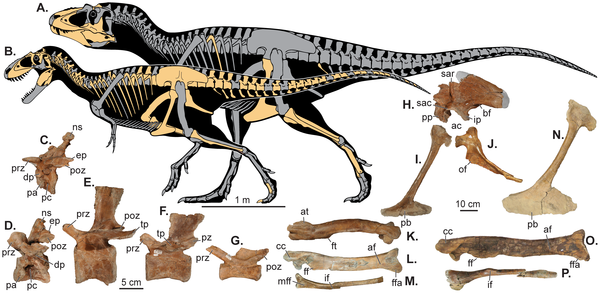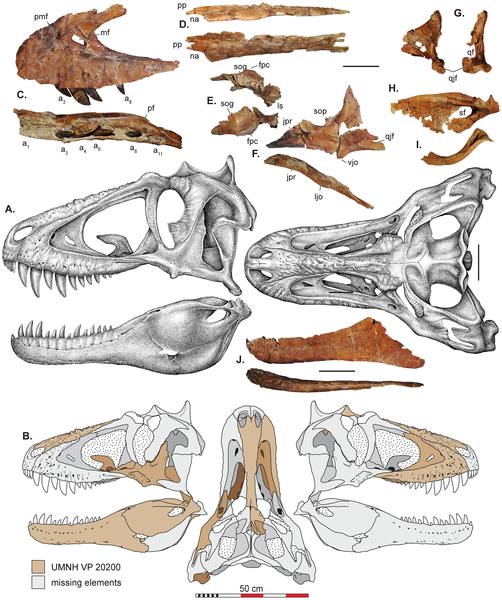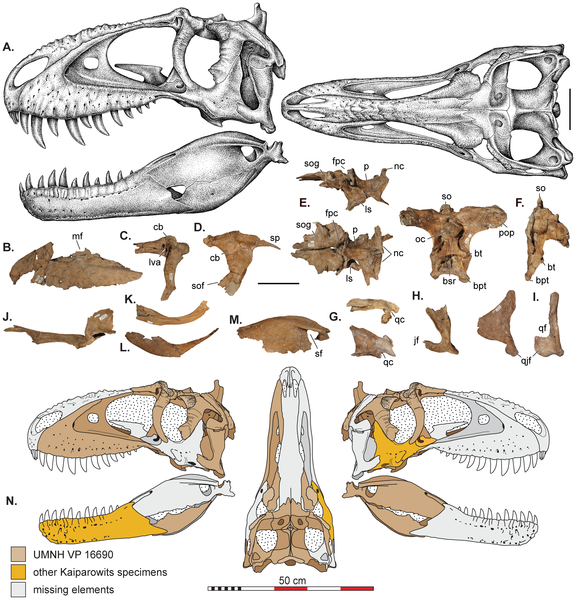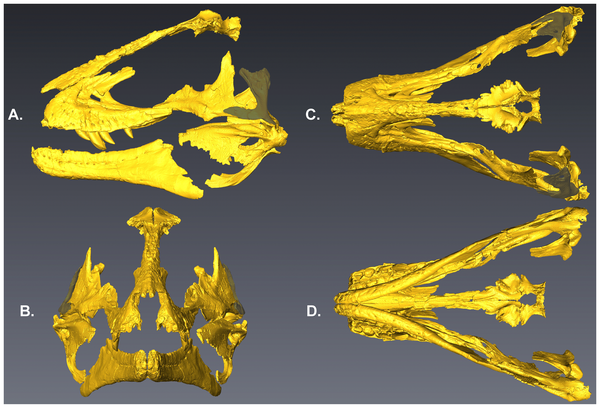The Late Cretaceous (~95–66 million years ago) western North American landmass of Laramidia displayed heightened non-marine vertebrate diversity and intracontinental regionalism relative to other latest Cretaceous Laurasian ecosystems. Processes generating these patterns during this interval remain poorly understood despite their presumed role in the diversification of many clades. Tyrannosauridae, a clade of large-bodied theropod dinosaurs restricted to the Late Cretaceous of Laramidia and Asia, represents an ideal group for investigating Laramidian patterns of evolution. We use new tyrannosaurid discoveries from Utah—including a new taxon which represents the geologically oldest member of the clade—to investigate the evolution and biogeography of Tyrannosauridae. These data suggest a Laramidian origin for Tyrannosauridae, and implicate sea-level related controls in the isolation, diversification, and dispersal of this and many other Late Cretaceous vertebrate clades.

(A) Skeletal outlines showing recovered elements of Lythronax argestes (UMNH VP 20200) and (B) Teratophoneus curriei (UMNH VP 16690). Selected postcranial elements of Teratophoneus in left lateral view: (C) cervical vertebra 3; (D) cervical vertebra 9; (E–G) three caudal vertebrae; (H) right ilium (photoreversed with left illium in the background in grayscale); (I) pubis; (J) ischium; (K) right femur in lateral view; (L) right tibia in anterior view; and (M) right fibula in medial view. Elements of Lythronax figured include: (N) the left pubis in lateral view; (O), left tibia in anterior view (photoreversed); and (P) left fibula in medial view (photoreversed). Scale bar for a and b is 1 meter, c-g 5 cm and h-p 10 cm. Abbreviations: ac, acetabulum; af, astragalar facet; bf, brevis fossa; cc, cnemial crest; dp, diapophysis; ep, epipophysis; ff, fibular flange; ffa, fibular facet; ft, fourth trochanter; if, iliofibularis muscle scar; ip, ischial peduncle; lt, lesser trochanter; mff, fibular fossa; ns, neural spine; of, obturator flange; pa, parapophysis; pb, pubic boot; pc, pleurocoel; pp, pubic peduncle; poz, postzygapophysis; prz, prezygapophysis; sac, supraacetabular crest; sar, supraacetabular ridge; tp, transverse process.
doi:10.1371/journal.pone.0079420.g001

Skull reconstructions and selected cranial elements of Lythronax argestes.
These stippled reconstructions (A) are based on cranial elements recovered (B) for UMNH VP 20200. Selected elements of L. argestes holotype (UMNH VP 20200) including: (C) maxilla in lateral (photoreversed) and ventral views; (D) nasal in left lateral and dorsal view; (E) photoreversed frontal and laterosphenoid in lateral and dorsal view; (F) jugal in left lateral and dorsal view; (G) quadrate in left lateral and caudal view; (G) surangular in left lateral view; (I) prearticular in left lateral view; (J) dentary in lateral and ventral views. Abbreviations: a1-a11, alveoli 1–11; fpc, frontoparietal midsagittal crest; jf, jugal flange of the quadrate; jpr, jugal pneumatic recess; ljo, lateral jugal ornamentation; ls, laterosphenoid; mf, maxillary fenestra; na, naris; pf, palatine flange; pp, premaxillary process of nasal; qf, quadrate foramen; qjf, quadratojugal facet; sf, surangular foramen; sog, supraorbital groove; sop, suborbital process; vjo, ventral jugal ornamentation. Scale bars in A and C–J represent 10 cm and scale bar in B represents a total of 50 cm.
doi:10.1371/journal.pone.0079420.g002

Skull reconstructions and selected cranial elements of Teratophoneus curriei.
These stippled reconstructions (A) are based on all available material. Some of the preserved elements of the referred specimen T. curriei (UMNH VP 16690) including: (B) left maxilla in lateral view, (C) both lacrimals superimposed and in lateral view; (D) photoreversed postorbital in lateral view; (E) frontals, parietals, and laterosphenoids in lateral and dorsal views; (F) braincase in caudal and lateral view; (G) squamosal in lateral and dorsal views; (H) quadratojugal in lateral view; (I) quadrate in lateral and caudal views; (J) left palatine in lateral view; (K) prearticular in left lateral view; (L) angular in left lateral view; (M) surangular in lateral view. Element recovery maps (N) of T. curriei (UMNH VP 16690) from which the reconstruction in A are derrived. Other Kaiparowits T. curriei specimens include two right jugals (UMNH VP 16691 & BYU 8120) and a left dentary from BYU 8120. Abbreviations: bpt, basipterygoid process; bt, basal tubera; bsr, basisphenoid recess; cb, cornual boss; fpc, frontoparietal midsagittal crest; jf, jugal flange of the quadrate; ls, laterosphenoid; lva, lacrimal vacuity; mf, maxillary fenestra; nc, nuchal crest; oc, occipital condyle; p, parietal; pop, paroccipital process; qc, quadrate cotylus; qf, quadrate foramen; sf, surangular foramen; so, supraoccipital; sof, suborbital flange; sog, supraorbital groove. All scale bars represent 10 cm except N which represents 50 cm.
doi:10.1371/journal.pone.0079420.g003
![Sea level change and the hypothesized evolutionary diversification of Tyrannosauroidea. show more Sea level indicators include: (A) Time-calibrated phylogenetic relationships and paleobiogeographic distribution of tyrannosaurids with biogeographic origin indicated by color (see Methods and File S1 for details of analyses and the stratigraphic and phylogenetic relationships of tyrannosauroids within theropod dinosaurs). (B) Late Cretaceous regional transgression-regression cycles on Laramidia (brown [31]); global sea-level fluctuations (blue [34], [35]); and areal extent of Laramidia at minimum (alluvial plain) and maximum (alluvial plain and coastal plain) sea levels (green [1]). doi:10.1371/journal.pone.0079420.g004](http://worldfossilsociety.org/wp-content/uploads/2013/12/131029133124-large7.png)
Sea level change and the hypothesized evolutionary diversification of Tyrannosauroidea.
Sea level indicators include: (A) Time-calibrated phylogenetic relationships and paleobiogeographic distribution of tyrannosaurids with biogeographic origin indicated by color (see Methods and File S1 for details of analyses and the stratigraphic and phylogenetic relationships of tyrannosauroids within theropod dinosaurs). (B) Late Cretaceous regional transgression-regression cycles on Laramidia (brown [31]); global sea-level fluctuations (blue [34], [35]); and areal extent of Laramidia at minimum (alluvial plain) and maximum (alluvial plain and coastal plain) sea levels (green [1]).
doi:10.1371/journal.pone.0079420.g004

Reconstruction of the skull of Lythranax (UMNH VP 20200).
Elements were surface scanned and then digitally mirrored and expressed as a 3-D surface scan in lateral (A), rostral (B), dorsal (C) and ventral (D) views. The quadratojugal, shaded gray, is that of Teratophoneus scaled to fit the larger skull of Lythronax. The quadratojugal is conservative across Tyrannosauridae and was used to place the quadrate.
doi:10.1371/journal.pone.0079420.g005
Citation: Loewen MA, Irmis RB, Sertich JJW, Currie PJ, Sampson SD (2013) Tyrant Dinosaur Evolution Tracks the Rise and Fall of Late Cretaceous Oceans. PLoS ONE 8(11): e79420. doi:10.1371/journal.pone.0079420
Editor: David C. Evans, Royal Ontario Museum, Canada



 December 22nd, 2013
December 22nd, 2013  Riffin
Riffin  Posted in
Posted in  Tags:
Tags: 